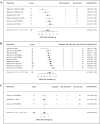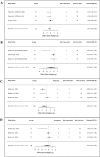A systematic review and meta-analysis of neuromodulation therapies for substance use disorders
- PMID: 38086901
- PMCID: PMC10876556
- DOI: 10.1038/s41386-023-01776-0
A systematic review and meta-analysis of neuromodulation therapies for substance use disorders
Abstract
While pharmacological, behavioral and psychosocial treatments are available for substance use disorders (SUDs), they are not always effective or well-tolerated. Neuromodulation (NM) methods, including repetitive transcranial magnetic stimulation (rTMS), transcranial direct current stimulation (tDCS) and deep brain stimulation (DBS) may address SUDs by targeting addiction neurocircuitry. We evaluated the efficacy of NM to improve behavioral outcomes in SUDs. A systematic literature search was performed on MEDLINE, PsychINFO, and PubMed databases and a list of search terms for four key concepts (SUD, rTMS, tDCS, DBS) was applied. Ninety-four studies were identified that examined the effects of rTMS, tDCS, and DBS on substance use outcomes (e.g., craving, consumption, and relapse) amongst individuals with SUDs including alcohol, tobacco, cannabis, stimulants, and opioids. Meta-analyses were performed for alcohol and tobacco studies using rTMS and tDCS. We found that rTMS reduced substance use and craving, as indicated by medium to large effect sizes (Hedge's g > 0.5). Results were most encouraging when multiple stimulation sessions were applied, and the left dorsolateral prefrontal cortex (DLPFC) was targeted. tDCS also produced medium effect sizes for drug use and craving, though they were highly variable and less robust than rTMS; right anodal DLPFC stimulation appeared to be most efficacious. DBS studies were typically small, uncontrolled studies, but showed promise in reducing misuse of multiple substances. NM may be promising for the treatment of SUDs. Future studies should determine underlying neural mechanisms of NM, and further evaluate extended treatment durations, accelerated administration protocols and long-term outcomes with biochemical verification of substance use.
© 2023. The Author(s).
Conflict of interest statement
TPG is a co-principal editor at Neuropsychopharmacology. CAH is employed by BrainsWay and has a financial interest in the company. The remaining authors have nothing to disclose.
Figures





References
-
- Substance Abuse and Mental Health Services Administration. Key substance use and mental health indicators in the United States: results from the 2021 National Survey on Drug Use and Health. 2022. https://www.samhsa.gov/data/sites/default/files/reports/rpt39443/2021NSD....
-
- United Nations Office on Drugs and Crime. World Drug Report 2020. 2020. https://www.unodc.org/unodc/data-and-analysis/world-drug-report-2022.html.

